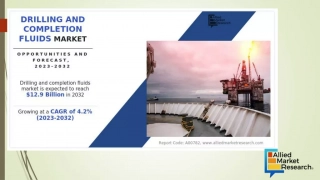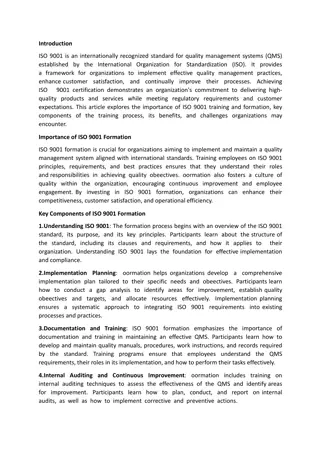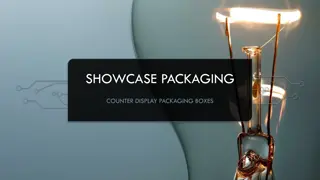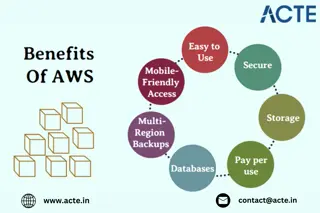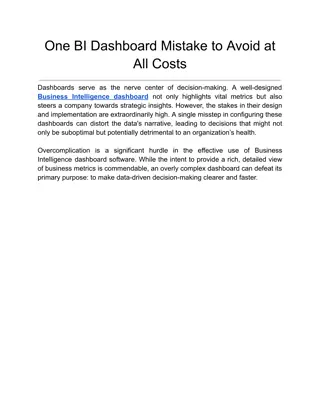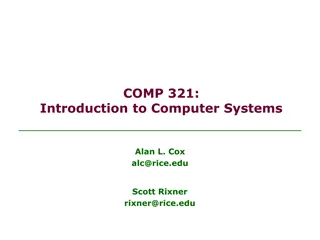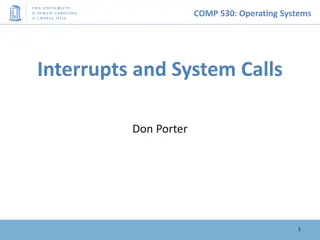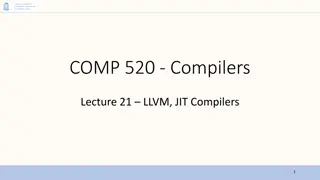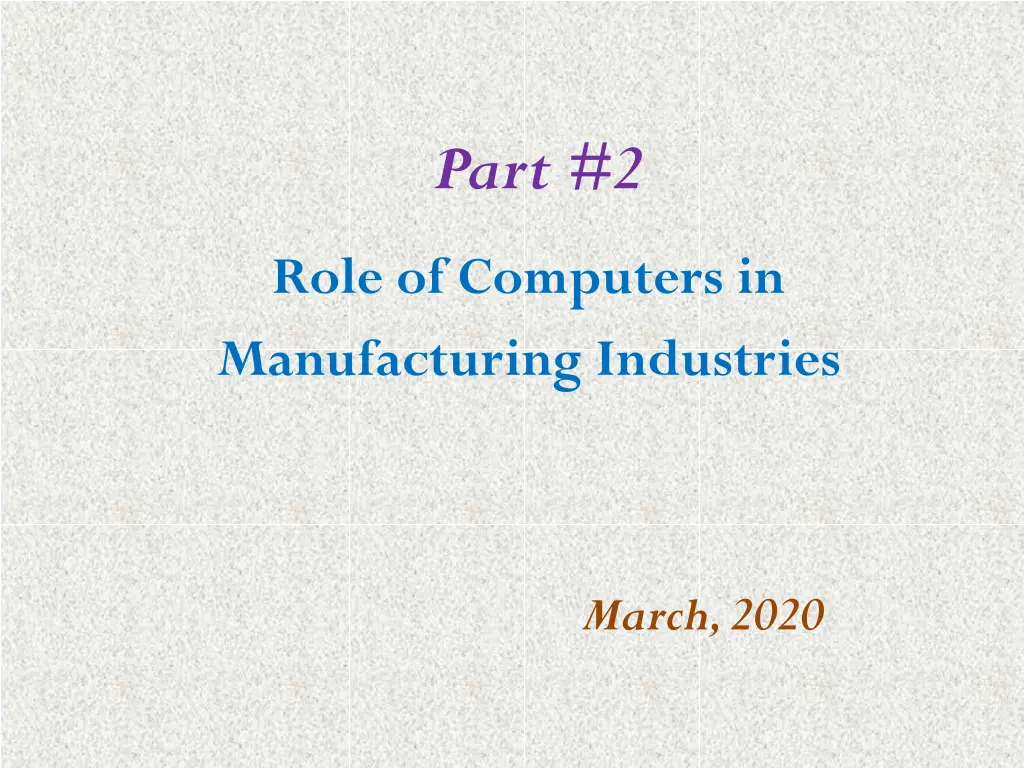
Roles of Computers in Manufacturing Industries: Enhancing Efficiency
Explore the pivotal role of computers in various aspects of manufacturing industries, including design processes, production control, and quality assurance. Learn how computer-based technologies have revolutionized the manufacturing sector, optimizing productivity and cost-effectiveness.
Download Presentation

Please find below an Image/Link to download the presentation.
The content on the website is provided AS IS for your information and personal use only. It may not be sold, licensed, or shared on other websites without obtaining consent from the author. If you encounter any issues during the download, it is possible that the publisher has removed the file from their server.
You are allowed to download the files provided on this website for personal or commercial use, subject to the condition that they are used lawfully. All files are the property of their respective owners.
The content on the website is provided AS IS for your information and personal use only. It may not be sold, licensed, or shared on other websites without obtaining consent from the author.
E N D
Presentation Transcript
Part #2 Role of Computers in Manufacturing Industries March, 2020
Outline: > Introduction > Computer in Engineering design > Computers in Manufacturing > Summary
1. Introduction Today s industrial climate is one of intense competitions with great emphasis being placed on reducing cost and improving productivity, product quality as well as reliability. To achieve these goals, manufacturers have had to adopt radical new techniques. The use of computers in various fields such as design, manufacturing, planning, control and quality has been of particular importance. The new computer based technologies have penetrated most areas of industries ranging from simple clerical functions of word processing to most sophisticated applications like aeronautics and the space shuttle program.
Contd Experience in the use of various computer based systems in industry has shown that while each can individually benefit the production process, these gains would be enhanced if the various systems are integrated and leads to the goal of achieving a fully integrated manufacturing system. CIM is a major long term research objective including elements such as robots, NC, CAD, process planning, manufacturing resource planning, etc.
2. Roles of Computers in Manufacturing Industries Computers have essential roles in different functions of manufacturing industries namely; 1) Design process 2) Manufacturing 3) Process planning 4) Production control and 5) Quality control.
a. Computers in Engineering Design Process i. Introduction Machines have been designed and built even before the advent of computers. During World War-II, ships, submarines, aircrafts and missiles were manufactured on a vast scale. In the significant era of industrial revolution, steam engines, water turbines, railways, cars and power-driven textile mills were developed. The method of representing three-dimensional solid objects and making the design process productive was soon needed.
ii. Design Process: > The process of designing something is characterized as an interactive procedure, which consists of six identifiable steps or phases: 1) Recognition of need 2) Definition of the need 3) Synthesis 4) Analysis and optimization 5) Evaluation 6) Presentation
Contd Recognition of needs involves realization by someone that a problem exists for which some corrective action can be taken in the form of a design solution. Problem definition of design by an engineer involves a thorough specification of the item to be designed. This specification includes the physical characteristics, function, cost, quality, and operating performance. Synthesis and analysis highly interactive in the design process. Consider the development of a certain product design: Each of the subsystems of the product must be conceptualized by the designer, analyzed, improved through this analysis procedure, redesigned, analyzed again, and so on. The process is repeated until the design has been optimized within the constraints imposed on the designer. The individual components are then synthesized and analyzed into the final product in a similar manner.
Contd # Evaluation: is concerned with measuring the design against the specifications established in the problem definition phase. This evaluation often requires the fabrication and testing of a prototype model to assess operating performance, quality, reliability, and other criteria. # Presentation: The final phase in the design procedure. The presentation is concerned with documenting the design by means of drawings, material specifications, assembly lists, and so on. In essence, documentation means that the design data base is created.
Problems in traditional design Process: Suboptimal design solution Costly Slow to response the market.
iii. Computer aided Design (CAD) CAD Technology = Design Techniques + Computers (HW+SW). CAD involves the effective use of the computer to create, modify, analyze, or document an engineering design. The computer systems consist of the hardware and software to perform the specialized design functions required by the particular user firm. The CAD hardware typically includes the computer, one or more graphics display terminals, keyboards, and other peripheral equipment. The CAD software consists of the computer programs to implement computer graphics on the system plus application programs to facilitate the engineering functions of the user company
Product Cycle in Conventional Manufacturing Environment
Product Cycle in an Computerized Manufacturing Environment
iv. Role of computers in Design Process: The design related tasks performed by Computers (CAD system) are: 1) Geometric modeling 2) Engineering analysis 3) Design review and evaluation and, 4) Automated drafting.
v. Benefits of use of computers in design process 1. To increase the productivity of the designer. > This is accomplished by helping the designer to conceptualize the product and its components. In turn, this helps to reduce the time required by the designer to synthesize, analyze, and document the design. 2. To improve the quality of design. > The use of a CAD system with appropriate hardware and software capabilities permits the designer to do a more complete engineering analysis and to consider a larger number and variety of design alternatives. The quality of the resulting design is thereby improved.
Contd 3. To improve documentation > The graphical output of a CAD system results in better documentation of the design than what is practical with manual drafting. The engineering drawings are superior, and there is more standardization among the drawings, fewer drafting errors, and greater legibility. 4. To create a data base for manufacturing. > In the process of creating the documentation for the product design (geometric specification of the product, dimensions of the components, materials specifications, bill of materials, etc.), much of the required data base to manufacture the product is also created.
2. Roles of Computers in Manufacturing i. Computer aided manufacturing (CAM) Over the last two decades, the impact of computers in manufacturing industry has been profound. On the shop floor, it is perhaps most evident in the form of numerically controlled and CNC machine tools. In these types of machines, all the manufacturing functions can be controlled using numerical data usually supplied via punched tape or magnet tape; or in the case of CNC directly from a computer.
Contd CAM refers to the use and application of computers in all aspects of manufacturing. CAM = Computers + Manufacturing Computers can be used to replace manual effort and to act as an interface between human and machine facilitating in many ways. One of the roles of computers in manufacturing is to control the manufacturing operations of machines/devices such as: Machine Tools (CNC Machines) Inspection Equipments (CMM) Material Handling Devices (Robots) and Other machines (Rapid Prototyping)
Computer Controlled Machines CNC (Computer Numerically Controlled) Machines
Contd CMM (Coordinate Measuring Machine)
Contd Rapid prototyping (RP) refers to a new class of manufacturing processes which quickly produce physical prototypes from 3D CAD models.
Contd Computer Controlled Factories
Computer Based Simulation Machining Simulation
Contd Assembly Simulation
3. Computer in Integrating Manufacturing (CIM) In today s global arena, to meet the market demands & to survive the Role of computers in integrating manufacturing system is an enabling technology to meet the above requirements to the manufacturing. competition, manufacturing company needs to be flexible, adaptable and responsive to changes and be able to produce a variety of products in short time and at lower cost. Computer integrated manufacturing (CIM), which emerged in 1970, was the outcome of this protracted search.
Contd CIM is the phrase used to describe the complete automation of a manufacturing plant, with all processes functioning under computer control and digital information tying them together. CIM encompasses the entire range of product development and manufacturing activities with all the functions being carried out with the help of dedicated software packages. The data required for various functions are passed from one application software to another in a seamless manner. CIM uses a common database wherever feasible and communication technologies to integrate design, manufacturing and associated business functions that combine the automated segments of a factory or a manufacturing facility. CIM reduces the human component of manufacturing and thereby relieves the process of its slow, expensive and error-prone component.
Contd CIM is a broad term covering all technologies and soft automation used to manage the resources for cost effective production of tangible goods.
4. Computers in Process Planning In manufacturing, the goal is to produce components that meet the design specifications. The design specification ensures the functionality aspect. Next step to follow is to assemble these components into final product. Process planning acts as a bridge between design and manufacturing by translating design specification into manufacturing process detail. Hence, in general, process planning is a production organization activity that transforms a product design into a set of instruction (sequence of operation, machine tool setup, material requirements, etc.) to manufacture parts economically and competitively. The information provided in design includes dimensional specification (geometric shape and its feature) and technical specification (tolerance, surface finish etc.)
Two approaches to process planning: a) Manual experience-based process planning, and b) Computer-aided process planning method. i. Manual Process Planning: Following difficulties are associated with manual experienced based process planning method: 1) It is time consuming and over a period of time, plan developed are not consistent. 2) To generate a proper process plan, the process planner must have sufficient knowledge and experience. Hence, it is very difficult to develop the skill of the successful process planner and also a time consuming issue.
Contd ii. Computer-Aided Process Planning (CAPP) # CAPP is the application of computer to assistthe human process planer in the process planning function. In its lowest form it will reduce the time and effort required to prepare process plans and provide more consistent process plan. # In its most advanced state, it will provide the automated interface between CAD and CAM and in the process achieve the complete integration with in CAD/CAM. # Computers in CAPP helps to determine the processing steps required to make a part after CAPP has been used to define what is to be made. # CAPP programs develop a process plan or route sheet by following either a variant or a generative approach.
Advantages of CAPP over Manual Experience-based Process Planning i. It can systematically produce accurate and consistent process plans. ii. It leads to the reduction of cost and lead times of process plan. iii. Skill requirement of process planer are reduced to develop feasible process plan. iv. Interfacing of software for cost, manufacturing lead time estimation, and work standards can easily be done. v. Leads to the increased productivity of process planar.
The two approaches of CAPP: 1. Variant Approach CAPP The variant approach is comparable with the traditional manual approach where a process plan for a new part is created by recalling, identifying, and retrieving an existing process plan for similar part, and making necessary modification making it suitable for the new part. The variant approach uses a file of standard process plans to retrieve the best plan in the file after reviewing the design. The plan can then be revised manually if it is not totally appropriate.
Contd In general this system has two operational stages. i. Preparatory stage: in this stage the parts are coded and families are formed based on group technology (GT) principles. Standard process plans are prepared for each family and stored in database. ii. Production stage: Process plan for a new part can be made in this stage. Whenever a new part comes for process planning, it s code and family will be identified and the standard processing plan for that family is retrieved. Necessary modifications are made by the process planner to satisfy the component design.
Contd 2. Generative Approach CAPP # Generative process planning synthesizes process information in order to create process plans for a new component automatically. # The input of such systems may be either CAD drawing or models or text input. # The generative approach to CAPP starts with the product design specifications and can generate a detailed process plan complete with machine settings. # CAPP systems use design algorithms, a file of machine characteristics, and decision logic to build the plan. # The biggest advantage of this approach is that process plan developed is consistent and fully automated. This is especially useful for product mix of number of products with small lot sizes.
5. Computers in Manufacturing Process Monitoring & Control 5.1. Application areas of computers in manufacturing The role of computers in manufacturing can fall into two broad categories: 1. Computer monitoring and control. > These are the direct applications in which the computer is connected directly to the manufacturing process for the purpose of monitoring or controlling the process. 2. Manufacturing support applications. > These are the indirect applications in which the computer is used in support of the production operations in the plant, but there is no direct interface between the computer and the manufacturing process. > The distinction between the two categories is fundamental to an understanding of computer-aided manufacturing.
i. Computer Process Monitoring and Control Computer monitoring and control can be separated into monitoring applications and control applications. i. Computer process monitoring involves a direct computer interface with the manufacturing process for the purpose of observing the process and associated equipment and collecting data from the process. The computeris not used to control the operation directly. The control of the process remains in the hands of human operators, who may be guided by the information compiled by the computer.
Contd ii. Computer process control goes one step further than monitoring by not only observing the process but also controlling it based on the observations. With computer monitoring the flow of data between the process and the computer is in one direction only, from the process to the computer. In control, the computer interface allows for a two-way flow of data. Signals are transmitted from the process to the computer, just as in the case of computer monitoring. In addition, the computer issues command signals directly to the manufacturing process based on control algorithms contained in its software.
Contd In addition to the applications involving a direct computer- process interface for the purpose of process monitoring and control, computer-aided manufacturing also includes indirect applications in which the computer serves a support role in the manufacturing operations of the plant. In these applications, the computer is not linked directly to the manufacturing process. Instead, the computer is used "off-line" to provide plans, schedules, forecasts, instructions, and information by which the firm's production resources can be managed more effectively.
5.2. Types of Process Control system: 1. Open loop systems Programmed instructions are fed into the controller through an input device. These instructions are then converted to electrical pulses (signals) by the controller and sent to the servo amplifier to energize the servo motors. If the system performance is affected by load, temperature, humidity, or lubrication then the actual output could deviate from the desired output. Generally the open - loop system is used in point-to-point systems where the accuracy requirements are not critical.
Contd. 2. Closed loop systems The closed-loop system has a feedback subsystem to monitor the actual output and correct any discrepancy from the programmed input. These systems use position and velocity feedback and the feedback system could be either analog or digital. The analog systems measure the variation of physical variables such as position and velocity in terms of voltage levels. Digital systems monitor output variations by means of electrical pulses. To control the dynamic behavior and the final position of the machine slides, a variety of position transducers are employed.
Contd. If a discrepancy is revealed between where the machine element should be and where it actually is, the sensing device signals the driving unit to make an adjustment, bringing the movable component to the required location.
5.3. Levels of Industrial Process Control > In general, industrial control systems possess a hierarchical structure consisting of multiple levels of functions, similar to levels of automation. > Process control functions into three levels: 1) Basic control 2) Procedural control and 3) Coordination contro1. > These control levels map into automation hierarchy as shown in Figure next,
Figure Mapping of control levels into the levels of automation in a factory.
a. Basic Control This is the lowest level of control defined in the standard, corresponding to the device level in automation hierarchy. In the process industries, this level is concerned with feedback control in the basic control loops. In the discrete manufacturing industries, basic control is concerned with directing the servomotors and other actuators of the production machines. Basic control includes functions such as feedback control, polling, interlocking, interrupts. and certain exception handling actions. Basic control functions may be activated, deactivated, or modified by either of the higher control levels (procedural or coordination control) or by operator commands.
b. Procedural Control This intermediate level of control maps into regulatory control of unit operations in the process industries and into the machine level in discrete manufacturing automation. In continuous control, procedural control functions include using data collected during polling to compute some process parameter value, changing set points and other process parameters in basic control, and changing controller gain constants. In discrete control, the functions are concerned with executing the work cycle program, that is directing the machine to perform actions in an ordered sequence to accomplish some productive task.
c. Coordination Control This is the highest level in the control hierarchy. It corresponds to the supervisory level in the process industries and the cell or system level in discrete manufacturing. It is also likely to involve the plant and possibly the enterprise levels of automation. Coordination control initiates, directs, or alters the execution of programs at the procedural control level. Functions of coordination control at the cell/system level include coordinating the actions of groups of equipments or machines, coordinating material handling activities between machines in a cell or system, allocating production orders to machines in the cell, and selecting among alternative work cycle programs.
Contd At the plant/enterprise levels, coordination control is concerned with manufacturing support functions including production planning and scheduling; coordinating common resources such as equipment used in more than one production cell; and supervising availability, utilization. and capacity of equipment. These control functions are accomplished through the company's integrated computer and information system.
Summary Computers help in manifesting the qualitative conception of a design from a human in making a product. Further, they prove useful in creating, analysis and iterative improvement of the design, and its eventual realization. Computers are integrated with humans in design and manufacture, and provide the scope for automation (or least human interaction) wherever needed (mainly in analysis and optimization). Computers proved their immense role in manufacturing namely; Computer aided process planning (CAPP), monitoring (CAM), control (CAC), scheduling (CAS), tool path generation for CNC machining, flexible manufacturing system (FMS), robotic systems for assembly and manufacture, quality inspection, and many other manufacturing activities also require computers.

